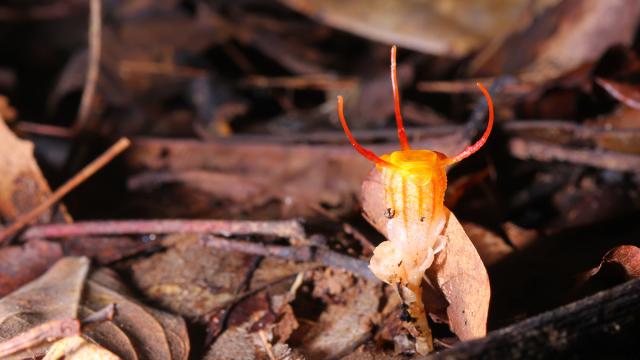It took a little while, but a tiny, delicate plant found in Japan 26 years ago has been formally classified as a new species. But after residing in a museum collection since the early 1990s, the single specimen of Thismia kobensis remains the only one ever found. Tragically, this means the so-called “fairy lantern” may already be extinct.
The plant’s roundabout way into the scientific literature began in June 1992, when botanists found its fragile, cup-shaped flower peeking above the leaf litter in an oak forest in Kobe, Japan. With its absence of green foliage, it was clearly a mycoheterotroph — a plant that has abandoned photosynthesis as a way to make food, instead using its roots to siphon nutrients away from fungi in the soil.
But outside of its parasitic nature, the plant was a mystery. Scientists collected the specimen, which came to reside at the Museum of Nature and Human Activities, Hyogo, where it stayed stored away for years.
Then, as part of an ongoing investigation into the biology of mycoheterotrophs, Kenji Suetsugu, a research scientist at Kobe University, re-examined the mysterious plant.
At first, it was thought to be closely-related to another mycoheterotroph found in Japan, Oxygyne hyodoi. But when the research team dissected the flower, they found differences in the plant’s reproductive structures that pegged it as a totally new species of Thismia, also known as fairy lanterns for their teeny, barely-discernible lamp-like flowers.
If you were hoping to see this strange little plant in the wild, you’re probably out of luck. After the first specimen was discovered in 1992, researchers combed the forest it was found in for seven years and couldn’t find any others. Then, in 1999, the area was cleared and paved over with an industrial park. In 2010, the odd plant without a name was declared extinct by Hyogo Prefecture.
“It is highly likely that the last individual has died, and this taxon is presumed extinct,” the authors wrote in a recent paper in the journal Phytotaxa, with the caveat that more comprehensive searching is needed to confirm this.
Martin Dančák, a botanist at Palacký University Olomouc in the Czech Republic not involved with the study, also thinks Thismia kobensis is likely gone for good.
“Sadly, I have to agree with authors that the plant is likely extinct. Thismia species usually have very small ranges and actually in most cases they are known only from their type localities (localities where they were discovered),” Dančák told us. “If its type locality was destroyed, there is very little chance it survives elsewhere.”
The story of the Japanese Thismia presents a striking parallel to that of another, almost legendary fairy lantern, according to Kenneth Wurdack, a research botanist and associate curator at the Smithsonian National Museum of Natural History. Thismia americana was discovered in a seemingly random plot of undeveloped prairie soil a century ago in Chicago, only to never be seen again.
But Wurdack was hopeful there may be individuals of the new species elsewhere, and suggested that future searches for the plant occur during a different time of year. He pointed to the recent rediscovery of a tropical fairy lantern, Thismia neptunis, 151 years after its initial discovery.
This propensity to show up briefly only to vanish without a trace is likely a consequence of fairy lanterns’ strange life-cycle. Since they don’t need to photosynthesise, they can lay dormant underground for years, only sending minuscule flowers to the surface when they’re in a reproductive mood.
The discovery of the new fairy lantern highlights the crucial role museum collections play in our understanding of Earth’s biodiversity. Wurdack noted that in the in the Smithsonian’s US National Herbarium alone, “we have hundreds of new species awaiting scientific description and further research”.
This lack of categorisation makes the loss of such collections — as what happened recently to zoological collections in the blaze at Brazil’s National Museum — a nearly immeasurable catastrophe.
Museums may be particularly important for our understanding of fairy lanterns, which are among the rarest plants on Earth, Dančák said. He suspects that rampant deforestation in Southeast Asia could have wiped out many before they were discovered. If it weren’t for scientists collecting a specimen of Thismia kobensis, it too could have been lost before it was ever found.
